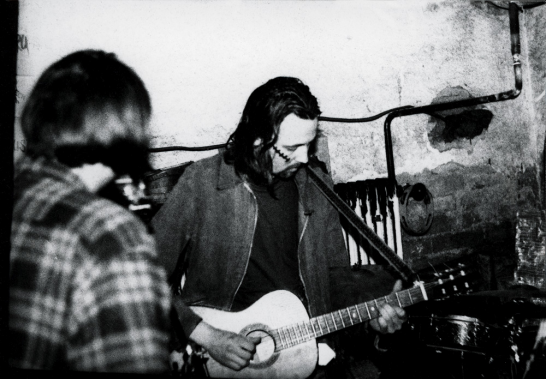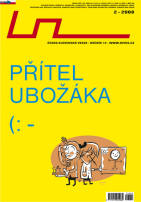| Umělec magazine 2008/2 >> S.d.Ch, Solitaires and Periphery Culture (a generation born around 1970) | List of all editions. | ||||||||||||
|
|||||||||||||
S.d.Ch, Solitaires and Periphery Culture (a generation born around 1970)Umělec magazine 2008/201.02.2008 Josef Jindrák | out - archeology | en cs de es |
|||||||||||||
|
Who is S.d.Ch? A person of many interests, active in various fields—literature, theater—known for his comics and collages in the art field. A poet and playwright foremost. A loner by nature and determination, his work doesn’t meet the current trends. He always puts forth personal enunciation, although its inner structure can get very complicated. It’s pleasant that he is a normal person and a great companion. His humor and verbal art would surely be worth a separate chapter. He has a family just as so many of us do, he goes to work (as a gravedigger) and deals with standard life situations. That’s how I see it; god knows what his wife would have to say about this. Sometime in the future it might be interesting to start interviewing artists’ wives.
It might not be apparent at first sight but S.d.Ch’s childhood in Prague’s concrete apartment district Jižní město, where he attended first grade elementary school, plays a very important role. Jižní město was at that time a typical humongous socialistic work site with no sidewalks or shops, littered with partially-completed sewer corridors and hills of dirt—a paradise for children but hell for their parents. There he had already met a few people that he’d keep on meeting years later. At the end of elementary school he tried to write his first romantic poems. He entered trade school with a neutral, indifferent attitude. Then came the essential influence of Ladislav Klíma, Otokar Březina, Jakub Deml and some time later Josef Váchal and Pierre de Lasenic. The Barrandov Four formed in the middle of the eighties. Wild drinking marathons in pubs that you’d preferably travel to through Zvíkov nature were more the art of living than work. The B4, other than SdCh were masker apprentices Jakub Žid, Stylus and Ondra Tejml. Petr Coufal, Jana Rokosová (today Židová), David Vokurka, Jana Viktorinová, photographer Petr Šafránek and others joined during later regular literary Wednesdays in Braník’s train station restaurant, where only original literature was tolerated. Shortly after November, elementary school classmate Petr Coufal’s libretto named the whole group Neslyšeli Zarathustru Orkestra (Those who didn’t hear Zarathusta Orkestra). Most of the Barrandov Four’s posse participated. Shows were performed only at country cottages and in gardens. Nobody would even think of offering them to perform in official clubs or put out records. The group slowly dissolved after several evolution stages. Its members turned to other activities and their families. S.d.Ch started writing and publishing poetry. The Goth band Ginnungagap formed in 1997. The founding fathers were Jakub Žid, Petr Coufal and Josef Jindrák, who had met Coufal while renting out his flat; and featured Jana Rokosová, and Roman Plischke—Josef Jindrák’s bandmate from the big-beat group J.K.H.CH—as a permanent guest. SdCh was surprisingly not invited to join. Ginnungagap’s existence provoked the birth of the Periphery 42 group. S.d.Ch composed, wrote and played the electric guitar, Martin Vocel played the drums, and newcomer Pepa Kytka strummed the bass. Later on, David Vokurka joined in on the fiddle and trumpet and Jana Viktorinová, author of several unique lino-cuts, came in on flute. Periphery 42 was active at a time when S.d.Ch began co-holding the Kadeřábek festival. Its visitors later formed bands so they could come and play at the next Kadeřábek—they were groups like Skrytý půvab byrokracie (The Discreet Charm of Bureaucracy) and Typ Skršín. Kadeřábek premiered S.d.Ch’s first theatre plays, David Vokurka’s paintings, Theatre Mimo, that introduced itself with Václav Havel’s Audience, with Pavel Hubený of J.K.H.CH. as the brewer—without the use of non-alcoholic beer. Kadeřábek also featured a Samizdat exhibition—and many years later S.d.Ch, Jana Viktorinová and Luboš Pavel started publishing their own books in their closed circle, illustrated by P. Formš with Jana Viktorina and David Vokurka. High-quality artistic bibliophilisms of P. Formš and the production of S.d.Ch’s publishing label Creatury culiny slach stood out from their publishing enterprise. S.d.Ch radically perfected his playwriting at the break of the nineties and the new century. Puppet-play Česká trilogie (Czech Triology) is truly a masterful Dadaistic slapstick comedy. Every three years a new play was written, set, and produced. I’m very curious what will theater critics say once they have discovered this. Puppets became the ideal media for S.d.Ch. He started writing his plays straight for marionettes, using his plentiful acting talent, which excelled at the last Kadeřábek, where he appeared with Varlén’s semi-automatic puppet machine. Through theater he met the posse around Karel Skalický and SPOŘ A OKO (Společnost pro obnovu Řepice a okolí – Association for the renewal of Řepice and surroundings). His marionette-scenic interpretation was even used in Skrytý půvab byrokracie’s program Opouštění fetiše (Abandoning Fetish) at the Alternativa 2006 festival. He produced his early mystery Návrat (Return) with his favorite Skrytý půvab byrokracie two years earlier. Today a new group—Ruce naší Dory (Our Dora’s Hands) has formed on the foundations of Periphery 42. Their songs are written exclusively by S.d.Ch. They have subsequently put out two albums at their own expense. The second one met with positive responses from the critics.
01.02.2008
Recommended articles
|
|||||||||||||











Comments
There are currently no comments.Add new comment